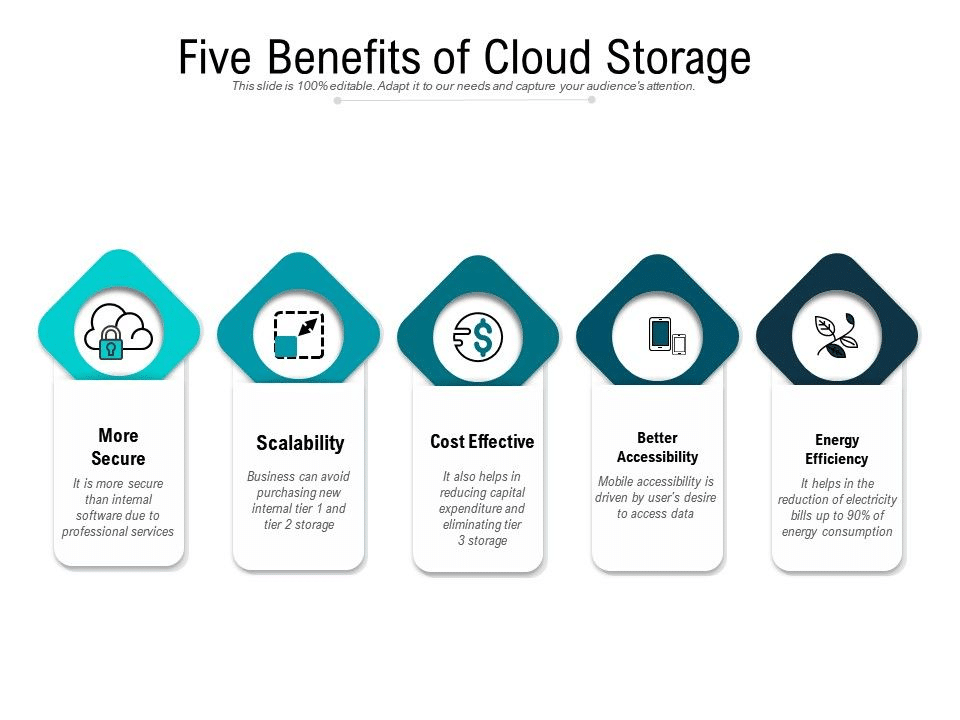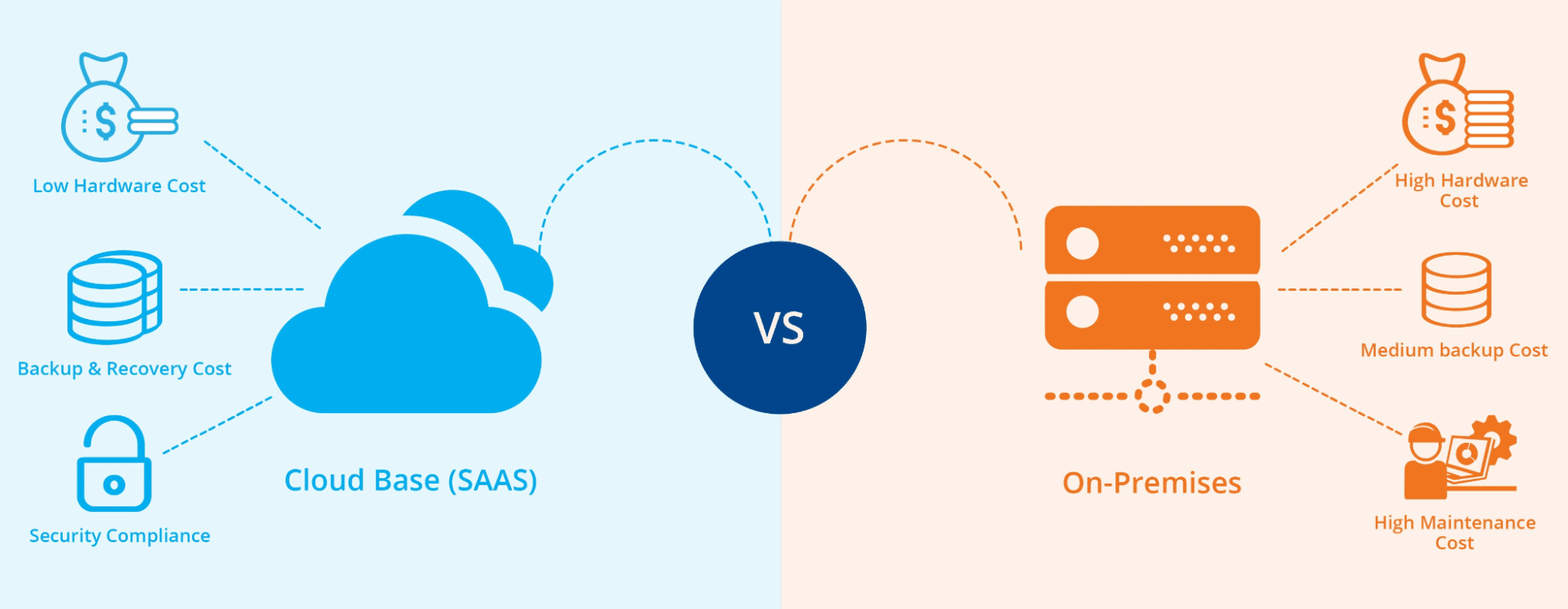“To cloud or not to cloud?” is a reasonable question that often boggles the minds of CTOs. On the one hand, there’s no shortage of articles praising the power of moving IT architecture to the cloud, improving operational flexibility and accessibility.
On the other hand, there have been talks about the unreliability of the cloud in the data security realms. Even big names like Apple, Google, or Dropbox struggle to protect their users, let alone smaller-scale cloud storage providers.
At the end of the day, which decision is the best one for your business? In this post, we will highlight the benefits and limitations of both cloud and on-premises storage, and outline scenarios in which one is more convenient than the other.
Why Do Companies Still Use On-Premises Storage?
Although there’s a lot of buzz around the cloud, a lot of teams are still reluctant about cutting ties with on-premises infrastructure. A lot of factors come into play–some are subjective, like the fear to embrace innovation and lack of desire to re-train the team. Others, however, are perfectly reasonable. After all, on-premises storage platforms have undeniable benefits.
Key Benefits of On-Premises Storage:
- A lot of room for customisation. Managed fully by the host, on-premises storage can always be updated to match the company’s needs. Business owners can tweak the interface and add features relevant for their field of operation and use cases. Such flexibility is outside the realm of possibility for vendor-backed solutions.
- Long-run cost-savings. On a short-term scale, cloud is cheaper than on-premises storage. However, years down the line, with the storage scaling and bandwidth consumption increasing, those who stayed on-premises will be winning in operational cost-cutting. Thus, if teams expect to scale their storage needs and process high data volumes in the future, on-premises is the way to go.
- Full control over security. Let’s not commit the fallacy of thinking that on-premises fully beats cloud in terms of data protection. There are numerous cases when hosting data infrastructure gives teams a false sense of safety. Making them, at the end of the day, more vulnerable to third-party attacks. The beauty of on-premises is in the fact that, if the team does care about cybersafety, you can create a protection system unmatched by third-party vendors.
Key Challenges of On-Premises Storage:
- Takes more time to deploy. When it comes to on-premises, there’s no instant access to resources. If teams are set to scale, they’d better have a plan and get ready to take their time. That’s why hosting their own storage can be agony for businesses operating in rapidly-changing fields.
- Unfit to support remote teams. Since on-premises storage is linked to a location, it’s not a viable solution for teams that don’t have physical headquarters. It is possible to make on-premises storage more accessible by investing in carrier and network services, but these are costly investments.
- Upfront investment. To host on-premises storage, business owners need to be ready to invest heavily. At the founding stage, most team leaders have no shortage of expenses and throwing on-premises infrastructure set-up into the pile will be a heavy burden. That’s why most on-premises adopters are the companies that don’t see implementation budgets as their main concern.
The Case For Cloud Computing
If you work in tech, chances are, you’ve seen this meme a ton on social media.

Although exaggerated, this anecdotal story gives a clear reflection of how big the cloud industry is these days. Statistically, the majority of companies have already shifted their data to the cloud, at least partially. The growth rate of cloud computing and storage is huge – here are a few facts and figures that prove the point:
- By 2023, the value of the cloud computing market will exceed $623 billion.
- In 2020, cloud storage generated over $305 billion in revenue.
- Business owners run 38% of processes in public and 41% in the private cloud.
- Amazon, Google, and Microsoft are the biggest cloud storage providers. Together, “The Big Three” account for over 57% of the market share.
Generally, data points to the fact that the future is, well, cloudy. However, does it mean that business owners should rush into moving all the parts of their infrastructure to vendor-backed, server-based storage? Not necessarily.
Let’s take a closer look at the benefits and limitations of cloud storage to understand why few companies move over 20% of their data to the cloud.
Key Benefits of Cloud Storage

1. On-demand resources help businesses react quickly
In 2021, the business landscape is highly dynamic. New ideas blow up and go out of style in a matter of months. Naturally, tech teams are under tremendous pressure to adapt, rolling out new releases and generating more content.
Typically, traditional storage models struggle to keep up with the pace of change. Gathering resources needed to scale a team’s data needs might take months, holding business owners back from seizing expansion opportunities. To that end, cloud storage is superior as it offers access to storage while, on the other hand, allowing the teams to scale down should they need to take a step back.
2. Cutting operating costs
Although there’s an ongoing debate as to whether or not cloud computing helps business owners save resources in the long run, the consensus is that it does. The reason for that is that, for cloud vendors, it’s cheaper to buy resources (servers, network capacity) in bulk, as opposed to individual companies.
Also, large-scale storage providers don’t need to hire staff to operate data centres. Instead, they invest in automation that propels cost savings in the long run. As cloud storage is cheaper for vendors, it becomes more affordable to end-users as well, helping teams that bring data storage and other elements like PBX to the cloud save both money and time.
3. Higher resiliency
Maintaining on-premises storage puts teams under the pressure of coming up with a Plan B in case of an infrastructure shutdown. Coming up with contingency strategies is expensive as it requires investing in tools that will be redundant until push comes to shove.
As a result, teams tend to bypass on-premises storage security, at the end of the day failing to contain single points of failure.
Cloud, on the other hand, provides business owners with ready-to-deploy resources that allow a quick way to bounce back in case of an infrastructure failure.
4. Less vulnerability to human error
A human-error-based server outage can be stratospherically expensive, costing teams up to $400,000 per hour. To that end, cloud storage is a better deal since most data management processes are automated.
Hence, as a rule of thumb, cloud computing tools have higher system stability and are a better fit for managing large-scale, complex infrastructures.
Key Challenges of Cloud Storage Implementation
In a perfect world, cloud storage would be an ideal solution–cheap, flexible, and agile. But, since ours is not a perfect world, there are a handful of “buts” that business owners need to consider before making a decision for or against the cloud. We will go over them below:
1. Challenges of a multi-cloud world
It’s rare for teams to host infrastructure on single-vendor-backed storage. According to McKinsey, 94% of companies have a multi-cloud infrastructure. It’s a smart move, but it throws in a couple of management hurdles, such as:
- Ensuring data protection regulation compliance across all storage.
- No way to get a big picture view of data stored across multiple cloud platforms.
- Need to build a data-sharing bridge between storage.
As a result, managing complex cloud infrastructures can, depending on the scale of the storage, get just as complex as running an on-premises archive.
2. Limited freedom and control

Another reasonable issue business owners have with the cloud is that they can’t have full control over data. The risk of being caught in the middle of a conflict of interests is too high. That’s why some teams ditch the cloud for good.
For example, when AWS announced its plans for file-sharing, Dropbox stopped using Amazon Web Services to host infrastructure. The team of a storage giant might’ve had reasonable concerns to make such a radical move.
3. No influence over the speed of transaction
Not being able to control data processing is another reason to be skeptical about the cloud. Of course, typically business owners don’t need granular precision in controlling transaction processing.
However, in industries like finance, the processing rate should be so high that cloud-based storage would not be able to keep up. That’s why The Wall Street infrastructure, for example, is maintained on premises.
Cloud vs On-Premises Storage: Key Differences

Now that we are clear on both benefits and limitations of these highly-discussed types of data storage, let’s compare the process of managing both side-by-side. Take a look at the table highlighting the key differences between cloud and on-premises data storage tools:
| Cloud | On-Premises | |
| Maintenance cost | Is included in the implementation fee. | Requires in-house resources and consulting. |
| Implementation cost | Cheaper in the short-run. In the long run, paying monthly fees might become more expensive than owning resources. | Typically more expensive as the team needs to invest in hardware, as well as talent needed to maintain the infrastructure. |
| Software requirements | No specific requirements – the team can access the storage using a device connected to the Internet. | High server capacity, software, and hardware needed to maintain the storage, high bandwidth, backup infrastructure. |
| Data ownership | Data ownership is negotiable – some vendors want to co-own stored data while others hand ownership off completely. | Data is typically owned by the company itself. |
| Data security | Cloud storage has a wide user base which calls for robust security infrastructure. On the other hand, third-party platforms are more vulnerable to outside attacks. | Depends on the dedication of the team. Typically, there’s less risk of data breaches but a higher number of human-error-related threats. |
| Staffing needs | No immediate need for internal staffing. | Internal staff is needed to manage the on-premises infrastructure. |
| Customisation | Limited and depends on the vendor. | Fully controlled by the company that hosts the storage. |
| Mobile access | Included in most cloud storage platforms. | Designing a mobile interface is up to the company. |
| Offline access | No or limited. | Depending on the needs of the company, there may be full offline availability. |
Cloud vs On-Premises Storage: Which One Should You Choose?
At the end of the day, there’s no obvious answer as to which of the two storage systems is better. However, there are scenarios that help business owners determine which way works for their companies.
You should choose on-premises if:
- You want to have full ownership of stored data.
- Security is a major concern–you want to set up advanced data protection systems and cloud vendors don’t meet your needs.
- It’s important for your team to have offline accessibility of the storage.
- You want to be able to customise the storage, add and remove features freely.
- You have enough resources to build, maintain, and scale on-premises storage.
You should choose cloud if:
- Accessibility is crucial. Since the cloud has no attachment to a particular location, it’s a powerful solution for fully remote teams.
- You don’t have enough resources or time to build a storage infrastructure from scratch.
- Your product and team are constantly changing and you want to quickly get on-demand resources as soon as you need them.
4 Industries That (Typically) Favour On-Premises Storage
While an individual company’s needs are the key criterion when choosing a type of storage, there are a few industry-specific conventions as to which type of file management system works better.
If your business is involved in one of the fields below, chances are, you would be safer and more comfortable with on-premises data storage.
1. Cybersecurity
Cybersecurity teams have high processing needs, according to IBM. An average company gets over 200,000 security alerts per day. For SIEM systems that serve a wide range of clients, this number is many times higher. Thus, cybersecurity teams need to have a superior infrastructure to the one offered by cloud vendors.
Besides that, since cybersecurity teams would be consuming a lot of bandwidth, the cost-saving benefit of the cloud will quickly dissipate. Data safety is another concern–a team offering cybersecurity services cannot afford to put clients at stake due to a hack of the cloud vendor.
2. Banking and finance

Financial institutions are reasonably wary of the cloud as well. To start with, banking and finance teams often have a long list of custom features they expect from their storage. Few vendors are willing to go the extra mile and adjust the interface to meet such granular needs.
Other than that, compared to other industries, finance does not have such a fast change rate. Hence, instant resource availability is not the main issue. On the other hand, security and data ownership are at stake, so on-premises infrastructure is a more convenient option.
3. Adtech
Advertising analytics and big data tools have become a huge presence in the modern-day business landscape, helping advertisers dodge ad-blockers and reach prospective clients. The main power of adtech providers comes from being able to aggregate and process terabytes of data. To offer such a high level of reliability, adtech teams need to invest a lot in powerful storage.
The reason why Adtech companies choose to host their data rather than hiring vendors is because of the need to scale storage on their own terms. On top of that, business owners are worried about intellectual property concerns. Using storage platforms owned by another ad tech provider (e.g. Google or Amazon) might put the company’s internal practices at risk of misuse.
4. Healthcare
Despite the fact that healthcare service providers handle an avalanche of data every day, the key reason to prefer on-premises over cloud storage is regulatory compliance. Healthcare service providers are monitored by tight sets of rules like HIPAA. A data leak can put a company’s activity at stake.
That’s why, in healthcare security, the sky’s the limit for protection measures. Also, healthcare institutions cannot afford downtime and should be able to access clinical records even if there’s no Internet connection. That’s why a lot of teams favour on-premises over cloud data storage.
4 Industries That Benefit From Cloud Adoption
While some fields are safer using on-premises data storage tools, for others, cloud is a more convenient, flexible, and scalable way to go. Here are the fields that will gain a lot after switching to the cloud.
1. Education

The key of online education is accessibility. That’s where the value of cloud storage is non-negotiable. By using the cloud, e-learning service providers, schools, and universities can make sure that students and teachers have one-click access to learning materials on a digital campus.
Other than that, most education institutions are in a tight spot financially and maintaining an on-premises storage infrastructure will further strain budgets. On the other hand, collaboration with a cloud vendor is flexible and allows teams to pay only for resources they use.
2. Hospitality
Hospitality is a rapidly-changing industry that, furthermore, has seasonal tendencies. In periods of peak activity, hospitality service providers might need to host large data volumes. On the other hand, when there isn’t much demand for tourism, business owners should have the freedom of scaling down.
To this end, cloud is a better choice as it spares teams the need to maintain a redundant infrastructure.
3. Real estate
In real estate, accessibility is a pinnacle of a business owner’s needs. With brokers being constantly on the move (at least, in the pre-pandemic world), the ability to access listings and client data anytime is vital.
With mobile accessibility and multi-device access, cloud is capable of supporting real estate teams scattered around the globe.
4. Non-profit
For non-profit managers, cost-saving is the main reason to move to the cloud. It’s not the only one. Other factors involve not having to engage volunteers willing to support the infrastructure and simplifying workflows (compared to on-premises storages, cloud platforms are typically more intuitive and take less time to master).
Conclusion
So, is cloud storage ultimately the future of data management? Generally, yes. With remote work becoming commonplace and the overall business environment growing increasingly more dynamic, it makes sense for business owners to go for the “I want it, I got it” resource management strategy.
However, it’s presumptuous to believe that cloud storage will fully replace on-premises. For some industries, not letting third-parties into their data warehouses is crucial, as is offline data accessibility. That’s why large-scale finance or healthcare companies might never transition to the cloud.
At the end of the day, there’s no right choice per se. All that’s left for business owners is to carefully assess the company’s priorities and choose the storage that meets these needs.
Originally published May 18, 2021, updated Jan 17, 2023
